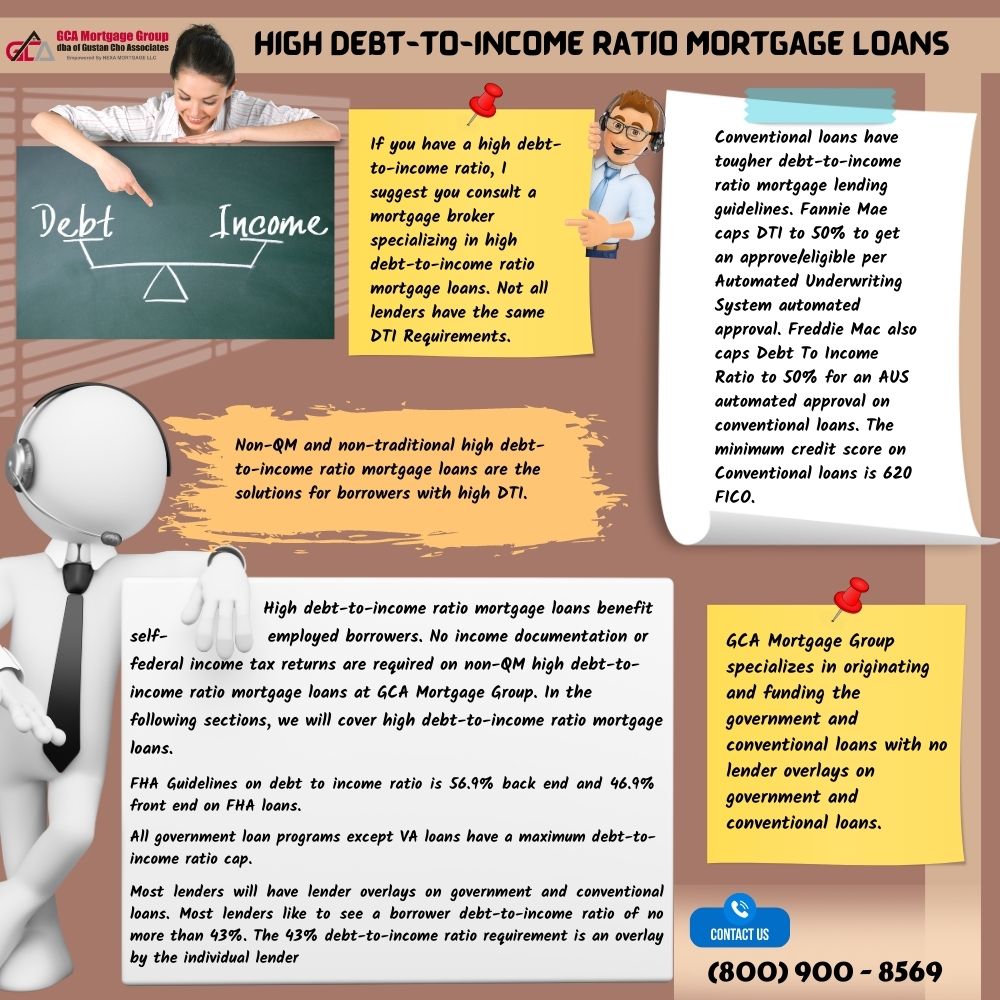High Debt-To-Income Ratio Mortgage Loans
Many new high debt-to-income ratio mortgage loans have been recently launched and introduced to the market. No-doc loans, DSCR mortgages, profit and loss statement-only mortgage loans, bank statement mortgages, and asset-depletion loans are some non-QM loan programs that do not require income docs and are based on other income/asset factors.
Many borrowers think they will not qualify for a mortgage loan because they have a high debt-to-income ratio. Many lenders have overlays on debt-to-income ratios. Large outstanding student loans are one of the biggest hurdles in not qualifying for a home mortgage due to high debt-to-income ratios. Deferred student loans for longer than 12 months are no longer exempt from debt-to-income ratio calculations unless they are VA loans.
Non-QM and non-traditional high debt-to-income ratio mortgage loans are the solutions for borrowers with high DTI. High debt-to-income ratio mortgage loans benefit self-employed borrowers. No income documentation or federal income tax returns are required on non-QM high debt-to-income ratio mortgage loans at Gustan Cho Associates. In the following sections, we will cover high debt-to-income ratio mortgage loans.
VA Loan Requirements on Deferred Student Loans
VA loans are the only home mortgage program that exempts deferred student loans that are deferred for longer than 12 months. FHA loans are the best home mortgage loan program for a high debt-to-income ratio.
If the borrower has a large outstanding student loan balance, the loan officer may want to switch the borrower to a conventional loan or FHA loan. Fannie Mae, Freddie Mac, and now HUD allow income-based repayment (IBR Payments) on conventional and FHA loans.
HUD, the parent of FHA, now allows income-based repayment. You can have zero IBR payment, and the zero monthly IBR payment will be used as your monthly student loan payment when underwriters calculate your debt-to-income ratios on both FHA and Conventional loans.
Agency Guidelines Versus Lender Overlays
All government and conventional loans need to meet the minimum agency mortgage guidelines. All government loan programs except VA loans have a maximum debt-to-income ratio cap.
Fannie Mae and Freddie Mac Agency Mortgage Guidelines cap debt-to-income ratios at 50% DTI on conventional loans. However, individual lenders can have stricter lending requirements called lender overlays on government and conventional loans.
Individual lenders can have lenders overlays that are lower than the maximum allowed by FHA, VA, USDA, Fannie Mae, and Freddie Mac.
Mortgage Companies With Lender Overlays
Case Scenario Of Lender Overlays: Most lenders will have lender overlays on government and conventional loans. Most lenders like to see a borrower debt-to-income ratio of no more than 43%. The 43% debt-to-income ratio requirement is an overlay by the individual lender and is not HUD Guidelines.
HUD Guidelines On Debt To Income Ratios allows up to 46.9% front-end DTI and 56.9% back-end DTI for borrowers with 620 credit scores or higher.
Gustan Cho Associates specializes in originating and funding the government and conventional loans with no lender overlays on government and conventional loans.
Lenders Specializing In High Debt-To-Income Ratio Mortgage Loans
If you have a high debt-to-income ratio, I suggest you consult a mortgage broker specializing in high debt-to-income ratio mortgage loans. Not all lenders have the same DTI Requirements.
Every lender has different lender overlays on debt-to-income ratio and credit score overlays. Just because one lender has a maximum debt-to-income ratio requirement of 43% doesn’t mean all lenders do.
As mentioned earlier, FHA Guidelines on debt to income ratio is 56.9% back end and 46.9% front end on FHA loans.
DTI Requirements on Conventional Loans
Conventional loans have tougher debt-to-income ratio mortgage lending guidelines. Fannie Mae caps DTI to 50% to get an approve/eligible per Automated Underwriting System automated approval. Freddie Mac also caps Debt To Income Ratio to 50% for an AUS automated approval on conventional loans. The minimum credit score on Conventional loans is 620 FICO.
Another way to solve a high debt-to-income ratio problem is to pay off existing debt and creditors. Paying off available credit card balances to eliminate the monthly payments would be a great start.
A car payment can usually be 300 dollars or more per month. Paying off a car loan can give a lot of buying power. Trading existing high-payment car payments for lower-car payments can help.
Non-Occupant Co-Borrowers Mortgage Guidelines
Borrowers with a high debt-to-income ratio trying to qualify for FHA loans can have non-occupant co-borrowers added to the loan. The Federal Housing Administration allows multiple non-owner-occupied co-borrowers. To qualify for a 3.5% down payment home purchase FHA loan with non-occupant co-borrowers, the non-occupant co-borrowers need to be related to the main borrower by blood, law, or marriage.
FHA Non-Occupant Co-Borrower Requirements Not Related To Borrowers
Non-occupant co-borrowers who are not related to the main borrower by law, blood, or marriage can still become non-occupant co-borrowers, but the main borrower needs to put a 25% down payment versus 3.5%.
Fannie Mae Freddie Mac allows non-occupant co-borrowers on conventional loans. Non-Occupant co-borrowers do not need to be related to the main borrower by law, marriage, or blood.
The only co-borrowers allowed on VA loans are the married spouse of the veteran borrower. Non-occupant co-borrowers are not allowed on VA loans. USDA loans do not allow for non-occupant co-borrowers.
Non-Traditional Income High Debt-To-Income Mortgage Loans
Mortgage lenders have income requirements. Overtime, part-time, and bonus income can be used as additional income. Overtime, part-time, commission and bonuses can be used as other income. This holds only if the borrower has a two-year history of earning such income.
If it is close to 2 years, a letter will be required by the company’s human resources department stating that the borrower will be guaranteed so many hours for the next six to twelve months can be used. Rental income can be used if declared on income tax returns. Depreciation can be added back as income if stated on income tax returns.
Mortgage borrowers with a higher debt-to-income ratio and looking for a lender with no lender overlays can call us at 800-900-8569 or text us for a faster response. Or email us at gcho@gustancho.com. The team at Gustan Cho Associates is available seven days a week, evenings, weekends, and holidays.









